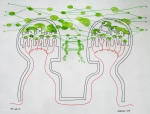
“It is advertising and the logic of mass consumerism that governs the depiction of reality in the mass media.” ~Christopher Lasch
As someone with SchizoAffective Disorder, there are certain aspects of socialized living that the SchizoAffected mind is unable to fathom and finds horrifying, terrifying and can result in a psychotic episode. One of such experiences, is spending a day shopping or patronizing too many stores, or running too many errands that can involve customizing too many stores. The Shopping Mall is simply out of the question. Also, the SchizoAffected Mind lives a non-druginduced psychadelic experience daily, as such, exposure to bright, flourescent lights, muzak, commercials playing at subvolume, muted and neuromarketed designs on the floors, ceilings, walls and layout of stores can result in information and sensual overload.
This is my experience of shopping.
The following sound painting (what I call the music/mixes/soundscapes I create) is an attempt to describe and illustrate the internal and psychic experience when I must visit a store. The beginning illustrates the first feelings of anxiety that quickly metamorph into an attempt to squelch the anxiety and just try to get through the act of choosing the items needed in order to exit the store as quickly as possible. As someone who also has Obsessive Compulsive Disorder, I often worry that I will be blamed for shoplifting, even though I have not, which causes me to walk about the store with my hands in my pockets or behind my back or up my shirt sleeves. The middle of the piece illustrates the dreadful feeling that slowly creeps in and the sort of sickly childish feeling of behaving like this, but being unable to stop it (hence the horror-like, chilling childrens’ theme). Once the psychosis begins to set in, the SchizoAffected mind begins to unravel and to shatter at the overload (hence, the noise, experimental music) as the end of the song approaches, and can feel as if the mind is trapped in a twisted game (which brings feelings and thoughts of paranoia).
(If the soundcloud player does not show up in your browser, here is the direct link).
*Image Credit (used with permission through CC license and fair use):
“1964. . . check out the check out!” by James Vaughn
Related articles
- A Look At The Abscence of Ego In The SchizoAffective Mind (forfreepsychology.wordpress.com)
- Psychotic Episode (I Have No Ego) (nikotheorb.wordpress.com)
- The difference between obsession and delusion – zoological method to classify symptoms of OCD and schizophrenia in humans (medicalnewstoday.com)

 More than a century ago, scientists discovered something usual about how people with
More than a century ago, scientists discovered something usual about how people with 







